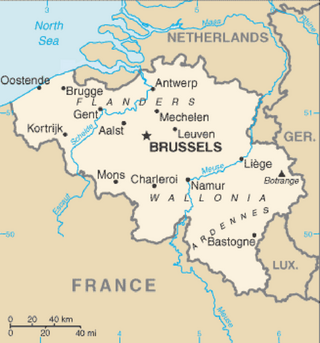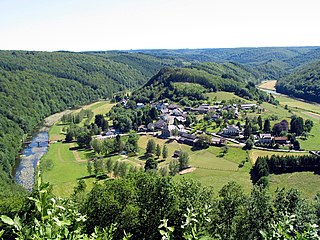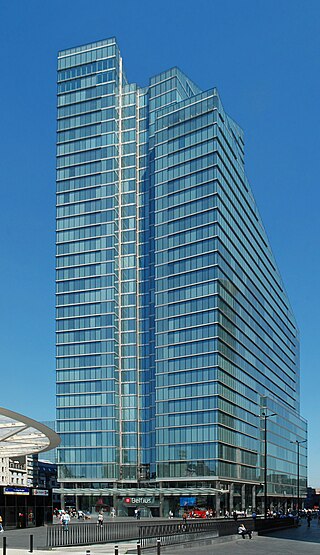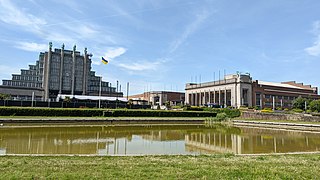
Brussels, officially the Brussels-Capital Region, is a region of Belgium comprising 19 municipalities, including the City of Brussels, which is the capital of Belgium. The Brussels-Capital Region is located in the central portion of the country and is a part of both the French Community of Belgium and the Flemish Community, but is separate from the Flemish Region and the Walloon Region.

Belgium is a federal state located in Western Europe, bordering the North Sea. Belgium shares borders with France (556 km), Germany (133 km), Luxembourg (130 km) and the Netherlands (478 km). Belgium is divided into three regions: Flanders, Wallonia and Brussels.

The Atomium is a landmark modernist building in Brussels, Belgium, originally constructed as the centrepiece of the 1958 Brussels World's Fair. Designed by the engineer André Waterkeyn and the architects André and Jean Polak as a tribute to scientific progress, as well as to symbolise Belgian engineering skills at the time, it is located on the Heysel/Heizel Plateau in Laeken, where the exhibition took place. Nowadays, it is the city's most popular tourist attraction, and serves as a museum, an art centre and a cultural destination.

The Grand-Place or Grote Markt is the central square of Brussels, Belgium. It is surrounded by opulent Baroque guildhalls of the former Guilds of Brussels and two larger edifices; the city's Flamboyant Town Hall, and the neo-Gothic King's House or Bread House building, containing the Brussels City Museum. The square measures 68 by 110 metres and is entirely paved.

The Ardennes, also known as the Ardennes Forest or Forest of Ardennes, is a region of extensive forests, rough terrain, rolling hills and ridges primarily in Belgium and Luxembourg, extending into Germany and France. Geologically, the range is a western extension of the Eifel; both were raised during the Givetian age of the Devonian, as were several other named ranges of the same greater range.

A hypermarket is a big-box store combining a supermarket and a department store. The result is an expansive retail facility carrying a wide range of products under one roof, including full grocery lines and general merchandise. In theory, hypermarkets allow customers to satisfy all their routine shopping needs in one trip. The term hypermarket was coined in 1968 by French trade expert Jacques Pictet.

The Federal Parliament is the bicameral parliament of Belgium. It consists of the Chamber of Representatives and the Senate. It sits in the Palace of the Nation. The Chamber of Representatives is the primary legislative body; the Senate functions only as a meeting place of the federal communities and regions.

The Palace of Justice of Brussels or Law Courts of Brussels is a courthouse in Brussels, Belgium. It is the country's most important court building, seat of the judicial arrondissement of Brussels, as well as of several courts and tribunals, including the Court of Cassation, the Court of Assizes, the Court of Appeal of Brussels, the Tribunal of First Instance of Brussels, and the Bar Association of Brussels.

The Congress Column is a monumental column in Brussels, Belgium, commemorating the creation of the Belgian Constitution by the National Congress of 1830–31. Inspired by Trajan's Column in Rome, it was erected between 1850 and 1859, on the initiative of the then-Prime Minister of Belgium, Charles Rogier, according to a design by the architect Joseph Poelaert. At the top of the column is a statue of Belgium's first monarch; King Leopold I, and at its base, the pedestal is surrounded by statues personifying the four freedoms guaranteed under the Constitution. The Belgian Tomb of the Unknown Soldier with an eternal flame lies at its foot.

Christkindelsmärik is a Christmas market held annually in Strasbourg, France on the Grande Île near Strasbourg Cathedral and Place Kléber. It draws in approximately 2 million visitors each year and since the arrival of TGV service in Strasbourg in 2007, the number of visitors has been on the rise. Hotels can be booked a year in advance and some receive between 15 and 17% of their yearly income thanks to the Christkindelsmärik's visitors. It is considered one of the most famous Christmas markets throughout Europe. It is estimated that the city benefits of a 16 million Euros profit from this 38-day-long tradition. It is mostly famous for its fragrance of mulled wine.

Ardenne Castle, or the Royal Castle of Ardenne was situated in Wallonia in the municipality of Houyet in Belgium not far from Ciergnon Castle and 15 kilometres (9.3 mi) from Dinant, was a royal castle that served as a luxury hotel from 1891 to 1949. It burned down in 1969.

Liège-Guillemins railway station, officially Liège-Guillemins, is the main station in Liège, Belgium. It is one of the most important hubs in the country and is one of the four Belgian stations on the high-speed rail network. The station is used by 15,000 people every day, which makes it the eleventh-busiest station in Belgium and the third in Wallonia. It is operated by the National Railway Company of Belgium (SNCB/NMBS).

The Rogier Tower is a skyscraper located in the Northern Quarter central business district of Brussels, Belgium. It owes its name to the Place Charles Rogier/Karel Rogierplein on which it is situated. It was formerly known as the Dexia Tower after Dexia bank, but that bank fell victim to the 2007–2012 global financial crisis and the tower's name was changed on 1 March 2012. As Dexia moved its offices in Brussels to the Bastion Tower in Ixelles, Belfius and its subsidiaries are the only occupants of this tower, often also called the Belfius Tower. It is the fourth tallest building in Belgium.

The Lisbon Christmas tree is an Artificial Christmas tree erected annually in Lisbon, Portugal since 2004.

Solar power in Belgium reached an installed capacity of 4,254 MW of power generating 3,563 GWh of electricity in 2018. In 2015 PV solar power accounted for around 4% of Belgium's total electricity demand, the 4th highest penetration figure in the world, although the country is some way behind the leaders Germany, Italy and Greece at between 7% and 8% of electricity demand.
The Folklore of Belgium is extremely diverse and reflects the rich legacy of cultural and religious influences which have acted on the region throughout its history, even before the establishment of the nation of Belgium in 1830. Much of Belgian folklore is unique to the region in which it is commemorated. Many aspects of folklore are manifested in public processions and parades in Belgian cities; traditions which are kept alive for the amusement of locals and tourists alike.
Tree was a controversial 24-metre (79 ft) high inflatable sculpture by the artist Paul McCarthy that was briefly installed in the Place Vendôme in Paris in October 2014 as part of a FIAC exhibition called "Hors les murs".

The Brussels Exhibition Centre, also known as Brussels Expo, is the most important event complex in Brussels, Belgium. Located on the Heysel/Heizel Plateau in Laeken, the twelve halls that comprise it are used for the largest national and international trade fairs, exhibitions and other events. With 115,000 m2 (1,240,000 sq ft) of facility space, they constitute the largest exhibition space in the Benelux. They are also a remarkable witness to the evolution of construction techniques during the 20th century.

Naziha Mestaoui was a Belgian artist trained in architecture, who lived and worked in Paris. She worked both collectively and individually, and received awards in several countries. As an environmental artist and activist, she was best known for One Heart, One Tree at the United Nations Climate Conference (COP21) in December 2015. The participatory art installation supports reforestation on several continents.

The Flower Carpet is a biennial event in Brussels in which volunteers from around Belgium convene at the Grand-Place/Grote Markt, the historic centre of the city, to weave a carpet-like tapestry out of colourful begonias. The event takes place every other August, coordinating with Assumption Day. Nearly a million flowers are required to create the ephemeral 1,800 m2 (19,000 sq ft) carpet.


















